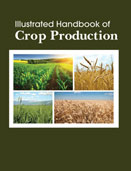Handbooks

Crop production is a branch of agriculture that deals with growing crops for use as food and fiber. Crop production includes grains, cotton, tobacco, fruits, vegetables, nuts and plants. A crop is any cultivated plant, fungus, or alga that is harvested for food, clothing, livestock, fodder, biofuel, medicine, or other uses. This handbook presents a structured discussion of the types of cultivars, the history of the crop, its uses and processing, a detailed discussion of how to plant and grow the crop, the pests and problems involved, and the harvesting, grading and marketing practices.
Crop production includes grains, cotton, tobacco, fruits, vegetables, nuts and plants. Different crops grow best in different areas of the country. Warmer climates are ideal for growing citrus crops; northern states are best for growing apples and blueberries and the Crop production depends on the availability of arable land and is affected in particular by yields, macroeconomic uncertainty, as well as consumption patterns; it also has a great incidence on agricultural commodities? prices. The importance of crop production is related to harvested areas, returns per hectare (yields) and quantities produced. Crop yields are the harvested production per unit of harvested area for crop products. In most of the cases yield data are not recorded, but are obtained by dividing the production data by the data on area harvested. The actual yield that is captured on farm depends on several factors such as the crop?s genetic potential, the amount of sunlight, water and nutrients absorbed by the crop, the presence of weeds and pests. This indicator is presented for wheat, maize, rice and soybean.
Illustrated Handbook of Crop Production is intended to provide a comprehensive coverage of the basic principles and practices required for sustainable crop production. It discover the ways to minimize undesirable nutrient losses and techniques for preserving the environment while meeting the challenges of providing the earth. In recent years, agricultural growth has accelerated remarkably, but most of this growth has been driven by increased yield per unit area rather than by expansion of the cultivated area. Looking towards 2030, to meet the demand for grain and to feed a growing population on the available arable land, it is suggested that annual crop production should be increased. Crop production will become more difficult with climate change, resource scarcity and environmental degradation. To pursue the fastest and most practical route to improved yield, the near-term strategy is application and extension of existing agricultural technologies. This would lead to substantial improvement in crop and soil management practices, which are currently suboptimal.
Illustrated Handbook of Crop Production provides graduate and undergraduate students with an up-to-date introduction to the techniques in crop production, including the challenge faced by science and technology in agriculture which must be met both in terms of increased crop productivity.